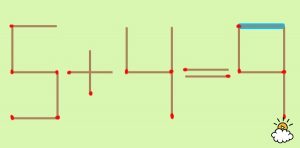
The goal of the game it consists in drag only one stick, to another place to make the math equation correct. The game can be played both in physical (using stick) and in ICT versions. In the ICT versions a calculation will appear on your computer screen. There are 20 questions at each level: easy, medium and hard.
Each of the numbers in equation is built from matchsticks. By moving only one matchstick, the player can fix the equation so that it is correct. The player must know which matchstick to move to make the math problem make sense.
Matchstick Math is a very challenging and fun game. Test Your Math Knowledge!
Basic information
Definition:
This game is a training of basic math operations – it consists in drag only one stick, to another place to make the math equation correct.
It can be played both in physical (using stick) and in ICT versions.

Objectives
The objective of the game is to move the stick to make the math equation correct. There are 20 questions at each level: easy, medium and hard. The player will have the message displayed on the screen “correct”.
This game can be very good to improve the following cognitive dimensions:
Duration
The duration depends on the capacity of solving the tasks; it usually takes about 10-15 minutes.
Cost:
- ICT version: free
- Physical version: free
References:
Development
Participants
Participants’ profile:
- Dementia level: game can be adjusted to match mild to moderate dementia levels.
- Physical requirements:
- Not high in general. For highly limited users, the game can be played using an assistant that follows the user’s instructions.
- For ICT game: good sight functions and also good functionality at arms and hands
Number of participants:
- This game can be played as solitaire, in pair (using stick for physical version )/ PC / laptop for ICT version) or in group cooperative (several players trying to make each equation correct) or in group competitive (with several sticks / PCs, and players in competition for winning the game – the fastest to solve the tasks and the most correct answers will win the game)
Material and requirements
- Materials needed to develop the game:
- ICT version: PC / laptop
- Physical version: sticks / matches
- Environment considerations: Good lighting levels. Avoid glare. Quiet environment, without distractive factors.
Support needed
Professionals / relatives can:
- Explain the game instructions
- Supervise the correct development of the game.
- Help with the counting / score
Starting point:
- ICT version: to open the window with the game, and then read the Instructions displayed in “How to play”. After this, select the level “Easy”, “Medium” or “Hard”, select the desired level, and the first equation appears on the screen.
- Physical version: The player starts solving the equations, using sticks.
This can be done as solitaire or in group.
Development:
The 20 equations/level that will appear on the screen successively with their solving. The player must drag only one stick, to another place to make the math equation correct.
Each of the numbers in equation is built from matchsticks. By moving only one matchstick, you can fix the equation so that it is correct. The player must know which matchstick to move to make the math problem make sense.
By soft only the correct move allows the passage to solving the next equation.
EXAMPLE: If the equation displayed is ” 6+4 = 4”
- The matchstick highlighted in blue is the one you want to move.
- The result will be: „5+4=9”


The game is over after the player solved 20 math problems. The player can play the next level, by clicking the „Medium” or „Hard” button in the center of the screen.
Additional information
Variants of the game:
- Physical game: the game can be played by using sticks.
- Group game: the game can be played in group, in a competitive or collaborative manner, in ICT or physical versions.
Alternative games:
Other related games:
Assessment:
- Number of mistakes
- Level reached
- Help needed
Practical activity
![]()
